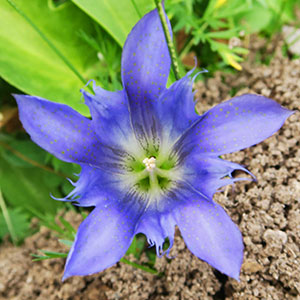Gentiana newberryi
Gentiana austromontana
alpine gentian, Newberry's gentian
Appalachian gentian, Blue Ridge or Roan Mountain or Appalachian gentian
1–5, arising laterally below rosettes, from a stout tap root, tufted, decumbent.
1–50, terminal from caudex, erect or nearly so.
basal and cauline;
blades of basal rosette and proximal cauline leaf blades widely spatulate to obovate or oblanceolate, 0.8–5 cm × 2–25 mm, apex obtuse or mucronate, at least these leaves with blades less than 6 times as long as wide, distal cauline leaves few, with blades oblanceolate to lanceolate or linear, 2–5 cm × 2–5 mm, apices acute.
cauline, ± evenly spaced;
blade lanceolate to ovate or elliptic, 3–12 cm × 10–30 mm, apex acute to acuminate.
terminal, flowers usually solitary, occasionally 2 or 3.
1–15-flowered heads, sometimes with additional flowers at 1–3 nodes or on short branches.
calyx 14–30 mm, lobes linear to narrowly ovate, (4–)6–12 mm, margins not ciliate;
corolla white or blue, campanulate, open, 23–55 mm, lobes spreading, elliptic-obovate, 7–17 mm, free portions of plicae divided into 2 triangular, serrate to lacerate segments;
anthers distinct.
calyx 8–25 mm, lobes lanceolate to ovate-triangular, narrowly ovate, or occasionally elliptic, 1.5–12 mm, margins ciliate;
corolla violet-blue, usually deeply colored, tubular, completely closed, 30–50 mm, lobes erect, triangular to nearly semicircular, 1.5–3 mm, free portions of plicae ± as long as lobes and ± 2 times as wide, deeply divided into 2 nearly equal, triangular to ± oblong segments, margins minutely erose;
anthers connate.
winged.
winged.
Gentiana newberryi
Gentiana austromontana
Varieties 2 (2 in the flora).
The two varieties of Gentiana newberryi intergrade extensively. The most distinctive form of var. newberryi, with relatively tall stems and medium to deep blue corollas, occurs in the northern part of the range of the species, from the Klamath and White mountains of California north into Oregon. Plants most clearly referable to var. tiogana prevail in the southern part of the range of the species, from Butte County south to Inyo and Tulare counties, California. In the central part of the range of the species, plant size and corolla color are less consistently correlated, with occasional plants combining low stature with deep blue corollas or tall stems with predominantly white or pale blue corollas. In that part of the range, corolla color may be highly variable within a single population.
The leaves of Gentiana newberryi are thick-textured and distinctively concave, usually spoon-shaped, when fresh. Narrower leaves sometimes occur in var. tiogana, but many plants of that variety have widely spatulate leaves like those of var. newberryi.
(Discussion copyrighted by Flora of North America; reprinted with permission.)
Because of the relatively late recognition of Gentiana austromontana as a distinct species, specimens of this species have been identified both as G. clausa and as G. decora. Gentiana austromontana is distinguished from G. andrewsii, G. clausa, and G. latidens by the combination of puberulent stems and calyx tubes with free portions of the corolla plicae that are about as long as the lobes and about twice as wide, divided into two more or less triangular segments each similar to a true lobe in size and shape. Because of its puberulence, it has been confused with G. decora, which differs in its more open, generally paler corollas with longer lobes and plicae, and usually narrowly linear calyx lobes.
Both Gentiana austromontana and G. decora occur in the higher elevations of eastern Tennessee and western North Carolina, although G. decora tends to occur in shadier habitats. These species are usually distinctly dissimilar, in each case bearing a greater resemblance to other species than to each other, but populations of plants variously intermediate between the two occur relatively frequently, especially in Greene and Unicoi counties, Tennessee. Plants otherwise typical of G. austromontana but with narrowly open corollas have been found in Mount Jefferson State Natural Area, Ashe County, North Carolina, and may be derived from introgression of genetic material from G. decora. Gentiana austromontana also hybridizes occasionally with G. clausa.
(Discussion copyrighted by Flora of North America; reprinted with permission.)
1. Corollas medium to deep blue with greenish to dark purple lines abaxially on and below lobes, usually 35–55 mm. | var. newberryi |
1. Corollas white to pale blue except for greenish to dark purple lines abaxially on and below lobes, usually 23–42 mm. | var. tiogana |


